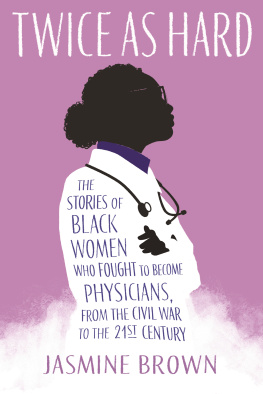Race and Medicine in
Nineteenth- and
Early-Twentieth-Century
America

Todd L. Savitt
THE KENT STATE UNIVERSITY PRESS
KENT, OHIO
2007 by The Kent State University Press, Kent, Ohio 44242
ALL RIGHTS RESERVED
Library of Congress Catalog Card Number 2006016314
ISBN-10: 0-87338-878-x
ISBN-13: 978-0-87338-878-8
Manufactured in the United States of America
10 09 08 07 06 5 4 3 2 1
LIBRARY OF CONGRESS CATALOGING-IN-PUBLICATION DATA
Savitt, Todd Lee, 1943
Race and medicine in nineteenth- and early-twentieth-century America / by Todd L. Savitt.
p. ; cm.
Includes bibliographical references and index.
ISBN-13: 978-0-87338-878-8 (hardcover : alk. paper)
ISBN-10: 0-87338-878-x (hardcover : alk. paper)
1. African AmericansHealth and hygieneSouthern StatesHistory19th century.
2. African AmericansMedical careSouthern StatesHistory19th century.
3. Sickle cell anemiaSouthern StatesHistory19th century.
4. RacismSouthern StatesHistory19th century.
I. Title.
[DNLM: 1. African AmericanshistoryUnited States. 2. Delivery of Health Care historyUnited States. 3. Anemia, Sickle CellhistoryUnited States. 4. Education, 20th CenturyUnited States. 5. History, 19th CenturyUnited States. 6. History, 20th CenturyUnited States. WA 11 AA1 S267r 2006]
RA448.5.N4S28 2006
362.1089'96073dc22 2006016314
British Library Cataloging-in-Publication data are available.
For Madison, Mitchell, and Jeremy
Contents
This collection of papers comprises a major portion of the writing I have done in the field of African American medical history. My work falls into three general areas: diseases and disorders of African Americans, blacks as patients during the antebellum and Reconstruction periods, and the education and medical practice of physicians of color in the late nineteenth and early twentieth centuries. For the most part, the subjects I write about have followed a logical, if not apparent, progression. After completing a book on slave health, Medicine and Slavery: The Diseases and Health Care of Blacks in Antebellum Virginia (1978), I published several articles based on information not included in that book, relating to slave life insurance, medical experimentation on slaves, and diseases such as crib death, elephantiasis, and sickle cell anemia. It then seemed fitting to investigate the health and health care of former slaves following emancipation. I began that project but kept stumbling on African American physicians (such as Alexander Augusta, the physician who ran the Freedmens Bureau hospital and dispensary in Savannah, Georgia) and wondered where these physicians came from and where they had obtained their medical training. Those questions led me from postbellum black health to medical education for African Americans. Between 1868 and 1900 some fourteen medical schools dedicated to the training of African American physicians were founded. I decided to learn as much as I could about those schools. That study led me to the question of what happened when newly minted physicians of color attempted to enter the essentially white medical profession of the late nineteenth and early twentieth centuries and, finally, to the issue of professionalization among black physicians, including the establishment of black medical journals and medical societies. My writings, then, basically trace (with some gaps) the story of African Americans and medicine in the South from colonial times to the early twentieth century.
I have revised the content of articles to update language and medical information, correct factual errors, clarify or embellish statements, standardize referencing format in the endnotes, and include citations in the references to recent scholarship where appropriate. I have also written introductions to the three articles on sickle cell anemia and the seven articles on the history of medical education for African Americans to reduce repetition of the same information in the articles themselves. Not all illustrations and tables that appeared in the original articles have been reproduced in the current volume. Readers wishing to view them should consult the original articles. Similarly, several charts that did not appear in the original articles have been added to the current volume.

Infant mortality in antebellum Virginia was extremely high. During the 1850s, between 16 and 20 percent of all deaths in the state occurred among children under the age of one year. The major causes of death included croup (much of which was probably diphtheria), diarrhea and dysentery, whooping cough, pneumonia, scarlet and other types of fever, and suffocation (also referred to as smothering and overlaying).
Typical historical cases of presumed overlaying share several of the unmistakable hallmarks of SIDS. Compare a twentieth-century physicians description of the latter with an overseers and a planters remarks on the former:
I [Nathaniel Ryan, overseer] am sorry to inform you [Edmund Hubard, slave owner] that Matilda has lost her youngest child she over laid it, it was well and hearty when she went to bed and found it dead sometime in the night.
Last week [wrote Robert Hubard to his brother, Edmund] Tilla overlaid/ when asleep/and killed her youngest childa boy 6 or 7 months old. This was no doubt caused by her own want of care and attention.
Most people, both today and 120 years ago, automatically assume that the fault lies with the parent and that the death is preventable. These are false assumptions. Physicians now know that children cannot be smothered as long as there is any circulating air available, even when the infant is beneath the covers or wedged against the sleeping mother.
(Studies published since the mid-1970s have revised this thinking. Commenting on that earlier view, a SIDS expert wrote in 2001, It is now recognized that occasionally infants can be overlaid, especially by a drug-affected or exhausted parent, or by a young sibling, that infants can suffocate under pillows or bedclothes, and that although rare, intentional suffocation of infants also occurs.)
In addition to this descriptive similarity between SIDS and overlaying, there is a remarkable epidemiological correspondence, in both age and seasonal variation. Crib death does not occur among children of all age groups. Those younger than two weeks and older than one year are almost entirely spared; those between two weeks and four months are prime victims. (The recent back to sleep campaign educating parents to put their infant children to sleep on their backs has resulted in a significant reduction in SIDS deaths, particularly in the highly susceptible two-to-four-month-old age group.
The relative incidence of purported overlaying was much lower in antebellum Virginia (about 4 percent of infant deaths) than that of SIDS in present-day America (26.5 percent of infant deaths between two weeks and eleven months of age) for several reasons. Because people did not understand the cause of sudden infant death, they usually classified it as unknown in most mortality lists. Even today we cannot explain this phenomenon of unexpected death in young babies, but rather than lump it with other unknown causes of death, medical scientists have provided us with the descriptive term Sudden Infant Death Syndrome.







